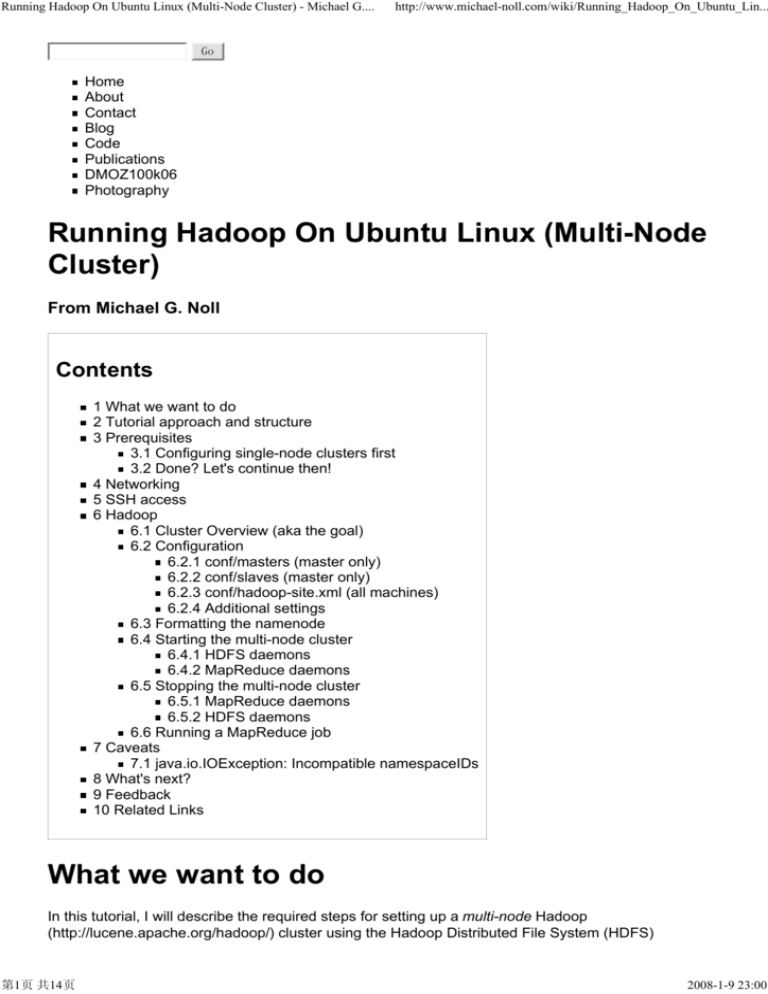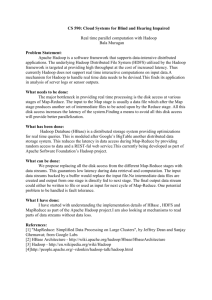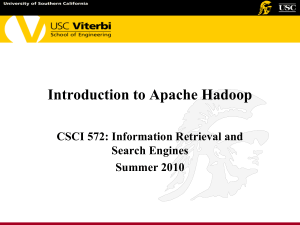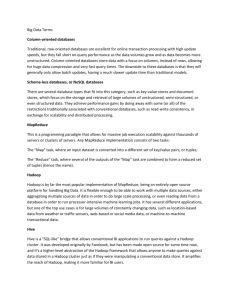Running Hadoop On Ubuntu Linux (Multi-Node Cluster)
advertisement

Running Hadoop On Ubuntu Linux (Multi-Node Cluster) - Michael G....
http://www.michael-noll.com/wiki/Running_Hadoop_On_Ubuntu_Lin...
Go
Home
About
Contact
Blog
Code
Publications
DMOZ100k06
Photography
Running Hadoop On Ubuntu Linux (Multi-Node
Cluster)
From Michael G. Noll
Contents
1 What we want to do
2 Tutorial approach and structure
3 Prerequisites
3.1 Configuring single-node clusters first
3.2 Done? Let's continue then!
4 Networking
5 SSH access
6 Hadoop
6.1 Cluster Overview (aka the goal)
6.2 Configuration
6.2.1 conf/masters (master only)
6.2.2 conf/slaves (master only)
6.2.3 conf/hadoop-site.xml (all machines)
6.2.4 Additional settings
6.3 Formatting the namenode
6.4 Starting the multi-node cluster
6.4.1 HDFS daemons
6.4.2 MapReduce daemons
6.5 Stopping the multi-node cluster
6.5.1 MapReduce daemons
6.5.2 HDFS daemons
6.6 Running a MapReduce job
7 Caveats
7.1 java.io.IOException: Incompatible namespaceIDs
8 What's next?
9 Feedback
10 Related Links
What we want to do
In this tutorial, I will describe the required steps for setting up a multi-node Hadoop
(http://lucene.apache.org/hadoop/) cluster using the Hadoop Distributed File System (HDFS)
第1页 共14页
2008-1-9 23:00
Running Hadoop On Ubuntu Linux (Multi-Node Cluster) - Michael G....
http://www.michael-noll.com/wiki/Running_Hadoop_On_Ubuntu_Lin...
(http://lucene.apache.org/hadoop/hdfs_design.html) on Ubuntu Linux (http://www.ubuntu.com/) .
Are you looking for the single-node cluster tutorial? Just head over there.
Hadoop (http://lucene.apache.org/hadoop/) is a framework written in Java for running applications on
large clusters of commodity hardware and incorporates features similar to those of the Google File
System (http://en.wikipedia.org/wiki/Google_File_System) and of MapReduce
(http://en.wikipedia.org/wiki/MapReduce) . HDFS (http://lucene.apache.org/hadoop/hdfs_design.html)
is a highly fault-tolerant distributed file system and like Hadoop designed to be deployed on low-cost
hardware. It provides high throughput access to application data and is suitable for applications that
have large data sets.
Figure 1: Cluster of machines running Hadoop at Yahoo! (Source: Yahoo!)
In a previous tutorial, I described how to setup up a Hadoop single-node cluster on an Ubuntu box.
The main goal of this tutorial is to get a more sophisticated Hadoop installation up and running, namely
building a multi-node cluster using two Ubuntu boxes.
This tutorial has been tested with the following software versions:
Ubuntu Linux (http://www.ubuntu.com/) 7.10, 7.04
Hadoop (http://lucene.apache.org/hadoop/) 0.15.2, released January 2008 (also works with
0.14.x and 0.13.x)
You can find the time of the last document update at the bottom of this page.
Tutorial approach and structure
From two single-node clusters to a multi-node cluster - We will build a multi-node cluster using
two Ubuntu boxes in this tutorial. In my humble opinion, the best way to do this for starters is to install,
configure and test a "local" Hadoop setup for each of the two Ubuntu boxes, and in a second step to
"merge" these two single-node clusters into one multi-node cluster in which one Ubuntu box will
become the designated master (but also act as a slave with regard to data storage and processing),
and the other box will become only a slave. It's much easier to track down any problems you might
encounter due to the reduced complexity of doing a single-node cluster setup first on each machine.
第2页 共14页
2008-1-9 23:00
Running Hadoop On Ubuntu Linux (Multi-Node Cluster) - Michael G....
http://www.michael-noll.com/wiki/Running_Hadoop_On_Ubuntu_Lin...
Figure 2: Tutorial approach and structure.
Prerequisites
Configuring single-node clusters first
The tutorial approach outlined above means that you should read now my previous tutorial on how to
setup up a Hadoop single-node cluster and follow the steps described there to build a single-node
Hadoop cluster on each of the two Ubuntu boxes. It's recommended that you use the same settings
(e.g., installation locations and paths) on both machines, or otherwise you might run into problems
later when we will migrate the two machines to the final multi-node cluster setup.
Just keep in mind when setting up the single-node clusters that we will later connect and "merge" the
two machines, so pick reasonable network settings etc. now for a smooth transition later.
Done? Let's continue then!
Now that you have two single-node clusters up and running, we will modify the Hadoop configuration to
make one Ubuntu box the master (which will also act as a slave) and the other Ubuntu box a slave.
We will call the designated master machine just the master from now on and the slave-only
machine the slave.
Shutdown each single-node cluster with <HADOOP_INSTALL>/bin/stop-all.sh before continuing
if you haven't done so already.
Networking
This should come as no surprise, but for the sake of completeness I have to point out that both
machines must be able to reach each other over the network. The easiest is to put both machines in
the same network with regard to hardware and software configuration, for example connect both
machines via a single hub or switch and configure the network interfaces to use a common network
第3页 共14页
2008-1-9 23:00
Running Hadoop On Ubuntu Linux (Multi-Node Cluster) - Michael G....
http://www.michael-noll.com/wiki/Running_Hadoop_On_Ubuntu_Lin...
such as 192.168.0.x/24.
To make it simple, we will assign the IP address 192.168.0.1 to the master machine and
192.168.0.2 to the slave machine. Update /etc/hosts on both machines with the following
lines:
# /etc/hosts (for master AND slave)
192.168.0.1
master
192.168.0.2
slave
SSH access
The hadoop user on the master (aka hadoop@master) must be able to connect a) to its own user
account on the master - i.e., ssh master in this context and not necessarily ssh localhost - and
b) to the hadoop user account on the slave (aka hadoop@slave) via a password-less SSH login. If
you followed my single-node cluster tutorial, you just have to add the hadoop@master's public SSH
key (which should be in $HOME/.ssh/id_rsa.pub ) to the authorized_keys file of
hadoop@slave (in this user's $HOME/.ssh/authorized_keys ).
The final step is to test the SSH setup by connecting with user hadoop from the master to the user
account hadoop on the slave. The step is also needed to save slave's host key fingerprint to the
hadoop@master's </tt>known_hosts</tt> file.
So, connecting from master to master...
hadoop@master:~$ ssh master
The authenticity of host 'master (192.168.0.1)' can't be established.
RSA key fingerprint is 3b:21:b3:c0:21:5c:7c:54:2f:1e:2d:96:79:eb:7f:95.
Are you sure you want to continue connecting (yes/no)? yes
Warning: Permanently added 'master' (RSA) to the list of known hosts.
Linux master 2.6.20-16-386 #2 Thu Jun 7 20:16:13 UTC 2007 i686
...
hadoop@master:~$
...and from master to slave.
hadoop@master:~$ ssh slave
The authenticity of host 'slave (192.168.0.2)' can't be established.
RSA key fingerprint is 74:d7:61:86:db:86:8f:31:90:9c:68:b0:13:88:52:72.
Are you sure you want to continue connecting (yes/no)? yes
Warning: Permanently added 'slave' (RSA) to the list of known hosts.
Ubuntu 7.04
...
hadoop@slave:~$
Hadoop
Cluster Overview (aka the goal)
The next sections will describe how to configure one Ubuntu box as a master node and the other
Ubuntu box as a slave node. The master node will also act as a slave because we only have two
machines available in our cluster but still want to spread data storage and processing to multiple
machines.
第4页 共14页
2008-1-9 23:00
Running Hadoop On Ubuntu Linux (Multi-Node Cluster) - Michael G....
http://www.michael-noll.com/wiki/Running_Hadoop_On_Ubuntu_Lin...
Figure 3: How the final multi-node cluster will look like.
The master node will run the "master" daemons for each layer: namenode for the HDFS storage layer,
and jobtracker for the MapReduce processing layer. Both machines will run the "slave" daemons:
datanode for the HDFS layer, and tasktracker for MapReduce processing layer. Basically, the "master"
daemons are responsible for coordination and management of the "slave" daemons while the latter will
do the actual data storage and data processing work.
Configuration
conf/masters (master only)
The conf/masters file defines the master nodes of our multi-node cluster. In our case, this is just
the master machine.
On master, update <HADOOP_INSTALL>/conf/masters that it looks like this:
master
conf/slaves (master only)
This conf/slaves file lists the hosts, one per line, where the Hadoop slave daemons (datanodes
and tasktrackers) will run. We want both the master box and the slave box to act as Hadoop slaves
because we want both of them to store and process data.
On master, update <HADOOP_INSTALL>/conf/slaves that it looks like this:
master
slave
If you have additional slave nodes, just add them to the conf/slaves file, one per line (do this on all
machines in the cluster).
第5页 共14页
2008-1-9 23:00
Running Hadoop On Ubuntu Linux (Multi-Node Cluster) - Michael G....
http://www.michael-noll.com/wiki/Running_Hadoop_On_Ubuntu_Lin...
master
slave
anotherslave01
anotherslave02
anotherslave03
Note:
The conf/slaves file on master is used only by the scripts like bin/start-dfs.sh or
bin/stop-dfs.sh. For example, if you want to add datanodes on the fly (which is not
described in this tutorial yet), you can "manually" start the datanode daemon on a new
slave machine via bin/hadoop-daemon.sh --config <config_path> start
datanode. Using the conf/slaves file on the master simply helps you to make "full"
cluster restarts easier.
conf/hadoop-site.xml (all machines)
Assuming you configured conf/hadoop-site.xml on each machine as described in the
single-node cluster tutorial, you will only have to change a few variables.
Important: You have to change conf/hadoop-site.xml on ALL machines as follows.
First, we have to change the fs.default.name
(http://lucene.apache.org/hadoop/hadoop-default.html#fs.default.name) variable which specifies the
NameNode (http://lucene.apache.org/hadoop/api/overview-summary.html) (the HDFS master) host
and port. In our case, this is the master machine.
<property>
<name>fs.default.name</name>
<value>hdfs://master:54310</value>
<description>The name of the default file system. A URI whose
scheme and authority determine the FileSystem implementation. The
uri's scheme determines the config property (fs.SCHEME.impl) naming
the FileSystem implementation class. The uri's authority is used to
determine the host, port, etc. for a filesystem.</description>
</property>
Second, we have to change the mapred.job.tracker
(http://lucene.apache.org/hadoop/hadoop-default.html#mapred.job.tracker) variable which specifies
the JobTracker (http://lucene.apache.org/hadoop/api/org/apache/hadoop/mapred/JobTracker.html)
(MapReduce master) host and port. Again, this is the master in our case.
<property>
<name>mapred.job.tracker</name>
<value>master:54311</value>
<description>The host and port that the MapReduce job tracker runs
at. If "local", then jobs are run in-process as a single map
and reduce task.
</description>
</property>
Third, we change the dfs.replication
(http://lucene.apache.org/hadoop/hadoop-default.html#dfs.replication) variable which specifies the
default block replication. It defines how many machines a single file should be replicated to before it
becomes available. If you set this to a value higher than the number of slave nodes (more precisely,
the number of datanodes) that you have available, you will start seeing a lot of (Zero targets
found, forbidden1.size=1) type errors in the log files.
The default value of dfs.replication is 3. However, we have only two nodes available, so we set
dfs.replication to 2.
第6页 共14页
2008-1-9 23:00
Running Hadoop On Ubuntu Linux (Multi-Node Cluster) - Michael G....
http://www.michael-noll.com/wiki/Running_Hadoop_On_Ubuntu_Lin...
<property>
<name>dfs.replication</name>
<value>2</value>
<description>Default block replication.
The actual number of replications can be specified when the file is created.
The default is used if replication is not specified in create time.
</description>
</property>
Additional settings
There are some other configuration options worth studying. The following information is taken from the
Hadoop API Overview (http://lucene.apache.org/hadoop/api/overview-summary.html) (see bottom of
page).
conf/hadoop-site.xml
mapred.local.dir
Determines where temporary MapReduce data is written. It also may be a list of directories.
conf/mapred-default.xml
(note that there is no conf/mapred-site.xml file!)
mapred.map.tasks
As a rule of thumb, use 10x the number of slaves (i.e., number of tasktrackers).
mapred.reduce.tasks
As a rule of thumb, use 2x the number of slave processors (i.e., number of tasktrackers).
Formatting the namenode
Before we start our new multi-node cluster, we have to format Hadoop's distributed filesystem (HDFS)
for the namenode. You need to do this the first time you set up a Hadoop cluster. Do not format a
running Hadoop namenode, this will cause all your data in the HDFS filesytem to be erased.
To format the filesystem (which simply initializes the directory specified by the dfs.name.dir
variable on the namenode), run the command
hadoop@master:/usr/local/hadoop$ bin/hadoop namenode -format
... INFO dfs.Storage: Storage directory /usr/local/hadoop-datastore/hadoop-hadoop/dfs/name has been successfully fo
hadoop@master:/usr/local/hadoop$
Background: The HDFS name table is stored on the namenode's (here: master) local filesystem in
the directory specified by dfs.name.dir. The name table is used by the namenode to store tracking
and coordination information for the datanodes.
Starting the multi-node cluster
Starting the cluster is done in two steps. First, the HDFS daemons are started: the namenode daemon
is started on master, and datanode daemons are started on all slaves (here: master and slave).
Second, the MapReduce daemons are started: the jobtracker is started on master, and tasktracker
daemons are started on all slaves (here: master and slave).
HDFS daemons
Run the command <HADOOP_INSTALL>/bin/start-dfs.sh on the machine you want the
namenode to run on. This will bring up HDFS with the namenode running on the machine you ran the
第7页 共14页
2008-1-9 23:00
Running Hadoop On Ubuntu Linux (Multi-Node Cluster) - Michael G....
http://www.michael-noll.com/wiki/Running_Hadoop_On_Ubuntu_Lin...
previous command on, and datanodes on the machines listed in the conf/slaves file.
In our case, we will run bin/start-dfs.sh on master:
hadoop@master:/usr/local/hadoop$ bin/start-dfs.sh
starting namenode, logging to /usr/local/hadoop/bin/../logs/hadoop-hadoop-namenode-master.out
slave: Ubuntu 7.04
slave: starting datanode, logging to /usr/local/hadoop/bin/../logs/hadoop-hadoop-datanode-slave.out
master: starting datanode, logging to /usr/local/hadoop/bin/../logs/hadoop-hadoop-datanode-master.out
master: starting secondarynamenode, logging to /usr/local/hadoop/bin/../logs/hadoop-hadoop-secondarynamenode-master
hadoop@master:/usr/local/hadoop$
On slave, you can examine the success or failure of this command by inspecting the log file
<HADOOP_INSTALL>/logs/hadoop-hadoop-datanode-slave.log . Exemplary output:
...
...
...
...
...
...
...
...
...
...
...
...
...
INFO
INFO
INFO
INFO
INFO
INFO
INFO
INFO
INFO
INFO
INFO
INFO
INFO
org.apache.hadoop.dfs.Storage: Storage directory /usr/local/hadoop-datastore/hadoop-hadoop/dfs/data is not
org.apache.hadoop.dfs.Storage: Formatting ...
org.apache.hadoop.dfs.DataNode: Opened server at 50010
org.mortbay.util.Credential: Checking Resource aliases
org.mortbay.http.HttpServer: Version Jetty/5.1.4
org.mortbay.util.Container: Started org.mortbay.jetty.servlet.WebApplicationHandler@17a8a02
org.mortbay.util.Container: Started WebApplicationContext[/,/]
org.mortbay.util.Container: Started HttpContext[/logs,/logs]
org.mortbay.util.Container: Started HttpContext[/static,/static]
org.mortbay.http.SocketListener: Started SocketListener on 0.0.0.0:50075
org.mortbay.util.Container: Started org.mortbay.jetty.Server@56a499
org.apache.hadoop.dfs.DataNode: Starting DataNode in: FSDataset{dirpath='/usr/local/hadoop-datastore/hadoo
org.apache.hadoop.dfs.DataNode: using BLOCKREPORT_INTERVAL of 3538203msec
As you can see in slave's output above, it will automatically format it's storage directory (specified by
dfs.data.dir) if it is not formatted already. It will also create the directory if it does not exist yet.
At this point, the following Java processes should run on master...
hadoop@master:/usr/local/hadoop$ jps
14799 NameNode
15314 Jps
14880 DataNode
14977 SecondaryNameNode
hadoop@master:/usr/local/hadoop$
(the process IDs don't matter of course)
...and the following on slave.
hadoop@slave:/usr/local/hadoop$ jps
15183 DataNode
15616 Jps
hadoop@slave:/usr/local/hadoop$
MapReduce daemons
Run the command <HADOOP_INSTALL>/bin/start-mapred.sh on the machine you want the
jobtracker to run on. This will bring up the MapReduce cluster with the jobtracker running on the
machine you ran the previous command on, and tasktrackers on the machines listed in the
conf/slaves file.
In our case, we will run bin/start-mapred.sh on master:
第8页 共14页
2008-1-9 23:00
Running Hadoop On Ubuntu Linux (Multi-Node Cluster) - Michael G....
http://www.michael-noll.com/wiki/Running_Hadoop_On_Ubuntu_Lin...
hadoop@master:/usr/local/hadoop$ bin/start-mapred.sh
starting jobtracker, logging to /usr/local/hadoop/bin/../logs/hadoop-hadoop-jobtracker-master.out
slave: Ubuntu 7.04
slave: starting tasktracker, logging to /usr/local/hadoop/bin/../logs/hadoop-hadoop-tasktracker-slave.out
master: starting tasktracker, logging to /usr/local/hadoop/bin/../logs/hadoop-hadoop-tasktracker-master.out
hadoop@master:/usr/local/hadoop$
On slave, you can examine the success or failure of this command by inspecting the log file
<HADOOP_INSTALL>/logs/hadoop-hadoop-tasktracker-slave.log . Exemplary output:
...
...
...
...
...
...
...
...
...
...
...
...
...
...
INFO
INFO
INFO
INFO
INFO
INFO
INFO
INFO
INFO
INFO
INFO
INFO
INFO
INFO
org.mortbay.util.Credential: Checking Resource aliases
org.mortbay.http.HttpServer: Version Jetty/5.1.4
org.mortbay.util.Container: Started org.mortbay.jetty.servlet.WebApplicationHandler@d19bc8
org.mortbay.util.Container: Started WebApplicationContext[/,/]
org.mortbay.util.Container: Started HttpContext[/logs,/logs]
org.mortbay.util.Container: Started HttpContext[/static,/static]
org.mortbay.http.SocketListener: Started SocketListener on 0.0.0.0:50060
org.mortbay.util.Container: Started org.mortbay.jetty.Server@1e63e3d
org.apache.hadoop.ipc.Server: IPC Server listener on 50050: starting
org.apache.hadoop.ipc.Server: IPC Server handler 0 on 50050: starting
org.apache.hadoop.mapred.TaskTracker: TaskTracker up at: 50050
org.apache.hadoop.mapred.TaskTracker: Starting tracker tracker_slave:50050
org.apache.hadoop.ipc.Server: IPC Server handler 1 on 50050: starting
org.apache.hadoop.mapred.TaskTracker: Starting thread: Map-events fetcher for all reduce tasks on tracker_
At this point, the following Java processes should run on master...
hadoop@master:/usr/local/hadoop$ jps
16017 Jps
14799 NameNode
15686 TaskTracker
14880 DataNode
15596 JobTracker
14977 SecondaryNameNode
hadoop@master:/usr/local/hadoop$
(the process IDs don't matter of course)
...and the following on slave.
hadoop@slave:/usr/local/hadoop$ jps
15183 DataNode
15897 TaskTracker
16284 Jps
hadoop@slave:/usr/local/hadoop$
Stopping the multi-node cluster
Like starting the cluster, stopping it is done in two steps. The workflow is the opposite of starting,
however. First, we begin with stopping the MapReduce daemons: the jobtracker is stopped on
master, and tasktracker daemons are stopped on all slaves (here: master and slave). Second, the
HDFS daemons are stopped: the namenode daemon is stopped on master, and datanode daemons
are stopped on all slaves (here: master and slave).
MapReduce daemons
Run the command <HADOOP_INSTALL>/bin/stop-mapred.sh on the jobtracker machine. This
will shut down the MapReduce cluster by stopping the jobtracker daemon running on the machine you
ran the previous command on, and tasktrackers on the machines listed in the conf/slaves file.
In our case, we will run bin/stop-mapred.sh on master:
第9页 共14页
2008-1-9 23:00
Running Hadoop On Ubuntu Linux (Multi-Node Cluster) - Michael G....
http://www.michael-noll.com/wiki/Running_Hadoop_On_Ubuntu_Lin...
hadoop@master:/usr/local/hadoop$ bin/stop-mapred.sh
stopping jobtracker
slave: Ubuntu 7.04
master: stopping tasktracker
slave: stopping tasktracker
hadoop@master:/usr/local/hadoop$
(note: the output above might suggest that the jobtracker was running and stopped on slave, but you
can be assured that the jobtracker ran on master)
On slave (strangely, and for a reason unknown to me), you will not see any information in the log file
<HADOOP_INSTALL>/logs/hadoop-hadoop-tasktracker-slave.log that the datanode
daemon has been shut down. However, you can list the running Java processes with jps as a
workaround as you can see below.
At this point, the following Java processes should run on master...
hadoop@master:/usr/local/hadoop$ jps
14799 NameNode
18386 Jps
14880 DataNode
14977 SecondaryNameNode
hadoop@master:/usr/local/hadoop$
...and the following on slave.
hadoop@slave:/usr/local/hadoop$ jps
15183 DataNode
18636 Jps
hadoop@slave:/usr/local/hadoop$
HDFS daemons
Run the command <HADOOP_INSTALL>/bin/stop-dfs.sh on the namenode machine. This will
shut down HDFS by stopping the namenode daemon running on the machine you ran the previous
command on, and datanodes on the machines listed in the conf/slaves file.
In our case, we will run bin/stop-dfs.sh on master:
hadoop@master:/usr/local/hadoop$ bin/stop-dfs.sh
stopping namenode
slave: Ubuntu 7.04
slave: stopping datanode
master: stopping datanode
master: stopping secondarynamenode
hadoop@master:/usr/local/hadoop$
(again, the output above might suggest that the namenode was running and stopped on slave, but
you can be assured that the namenode ran on master)
On slave (again strangely, and again for a reason unknown to me), you will not see any information
in the log file <HADOOP_INSTALL>/logs/hadoop-hadoop-datanode-slave.log that the
datanode daemon has been shut down. However, you can list the running Java processes with jps as
a workaround as you can see below.
At this point, the only following Java processes should run on master...
第10页 共14页
2008-1-9 23:00
Running Hadoop On Ubuntu Linux (Multi-Node Cluster) - Michael G....
http://www.michael-noll.com/wiki/Running_Hadoop_On_Ubuntu_Lin...
hadoop@master:/usr/local/hadoop$ jps
18670 Jps
hadoop@master:/usr/local/hadoop$
...and the following on slave.
hadoop@slave:/usr/local/hadoop$ jps
18894 Jps
hadoop@slave:/usr/local/hadoop$
Running a MapReduce job
Just follow the steps described in the section Running a MapReduce job of the single-node cluster
tutorial.
I recommend however that you use a larger set of input data so that Hadoop will start several Map and
Reduce tasks, and in particular, on both master and slave. After all this installation and
configuration work, we want to see the job processed by all machines in the cluster, don't we?
Here's the example input data I have used for the multi-node cluster setup described in this tutorial. I
added four more Project Gutenberg etexts to the initial three documents mentioned in the single-node
cluster tutorial. All etexts should be in plain text us-ascii encoding.
The Outline of Science, Vol. 1 (of 4) by J. Arthur Thomson
(http://www.gutenberg.org/etext/20417)
The Notebooks of Leonardo Da Vinci (http://www.gutenberg.org/etext/5000)
Ulysses by James Joyce (http://www.gutenberg.org/etext/4300)
The Art of War by 6th cent. B.C. Sunzi (http://www.gutenberg.org/etext/132)
The Adventures of Sherlock Holmes by Sir Arthur Conan Doyle
(http://www.gutenberg.org/etext/1661)
The Devil's Dictionary by Ambrose Bierce (http://www.gutenberg.org/etext/972)
Encyclopaedia Britannica, 11th Edition, Volume 4, Part 3 (http://www.gutenberg.org/etext/19699)
Download these etexts, copy them to HDFS, run the WordCount example MapReduce job on master,
and retrieve the job result from HDFS to your local filesystem.
Here's the exemplary output on master...
hadoop@master:/usr/local/hadoop$ bin/hadoop jar hadoop-0.13.0-examples.jar wordcount
... INFO mapred.FileInputFormat: Total input paths to process : 7
... INFO mapred.JobClient: Running job: job_0001
... INFO mapred.JobClient: map 0% reduce 0%
... INFO mapred.JobClient: map 28% reduce 0%
... INFO mapred.JobClient: map 57% reduce 0%
... INFO mapred.JobClient: map 71% reduce 0%
... INFO mapred.JobClient: map 100% reduce 9%
... INFO mapred.JobClient: map 100% reduce 68%
... INFO mapred.JobClient: map 100% reduce 100%
.... INFO mapred.JobClient: Job complete: job_0001
... INFO mapred.JobClient: Counters: 11
... INFO mapred.JobClient:
org.apache.hadoop.examples.WordCount$Counter
... INFO mapred.JobClient:
WORDS=1173099
... INFO mapred.JobClient:
VALUES=1368295
... INFO mapred.JobClient:
Map-Reduce Framework
... INFO mapred.JobClient:
Map input records=136582
... INFO mapred.JobClient:
Map output records=1173099
... INFO mapred.JobClient:
Map input bytes=6925391
... INFO mapred.JobClient:
Map output bytes=11403568
... INFO mapred.JobClient:
Combine input records=1173099
... INFO mapred.JobClient:
Combine output records=195196
... INFO mapred.JobClient:
Reduce input groups=131275
... INFO mapred.JobClient:
Reduce input records=195196
... INFO mapred.JobClient:
Reduce output records=131275
hadoop@master:/usr/local/hadoop$
第11页 共14页
gutenberg gutenberg-output
2008-1-9 23:00
Running Hadoop On Ubuntu Linux (Multi-Node Cluster) - Michael G....
http://www.michael-noll.com/wiki/Running_Hadoop_On_Ubuntu_Lin...
...and on slave for its datanode...
# from <HADOOP_INSTALL>/logs/hadoop-hadoop-datanode-slave.log on slave
... INFO org.apache.hadoop.dfs.DataNode: Received block blk_5693969390309798974 from /192.168.0.1
... INFO org.apache.hadoop.dfs.DataNode: Received block blk_7671491277162757352 from /192.168.0.1
<<<SNIPP>>>
... INFO org.apache.hadoop.dfs.DataNode: Served block blk_-7112133651100166921 to /192.168.0.2
... INFO org.apache.hadoop.dfs.DataNode: Served block blk_-7545080504225510279 to /192.168.0.2
... INFO org.apache.hadoop.dfs.DataNode: Served block blk_-4114464184254609514 to /192.168.0.2
... INFO org.apache.hadoop.dfs.DataNode: Served block blk_-4561652742730019659 to /192.168.0.2
<<<SNIPP>>>
... INFO org.apache.hadoop.dfs.DataNode: Received block blk_-2075170214887808716 from /192.168.0.2 and mirrored to /
... INFO org.apache.hadoop.dfs.DataNode: Received block blk_1422409522782401364 from /192.168.0.2 and mirrored to /1
... INFO org.apache.hadoop.dfs.DataNode: Deleting block blk_-2942401177672711226 file /home/hadoop/hadoop-datastore/
... INFO org.apache.hadoop.dfs.DataNode: Deleting block blk_-3019298164878756077 file /home/hadoop/hadoop-datastore/
...and on slave for its tasktracker.
# from <HADOOP_INSTALL>/logs/hadoop-hadoop-tasktracker-slave.log on slave
... INFO org.apache.hadoop.mapred.TaskTracker: LaunchTaskAction: task_0001_m_000000_0
... INFO org.apache.hadoop.mapred.TaskTracker: LaunchTaskAction: task_0001_m_000001_0
... task_0001_m_000001_0 0.08362164% hdfs://master:54310/user/hadoop/gutenberg/ulyss12.txt:0+1561677
... task_0001_m_000000_0 0.07951202% hdfs://master:54310/user/hadoop/gutenberg/19699.txt:0+1945731
<<<SNIPP>>>
... task_0001_m_000001_0 0.35611463% hdfs://master:54310/user/hadoop/gutenberg/ulyss12.txt:0+1561677
... Task task_0001_m_000001_0 is done.
... task_0001_m_000000_0 1.0% hdfs://master:54310/user/hadoop/gutenberg/19699.txt:0+1945731
... LaunchTaskAction: task_0001_m_000006_0
... LaunchTaskAction: task_0001_r_000000_0
... task_0001_m_000000_0 1.0% hdfs://master:54310/user/hadoop/gutenberg/19699.txt:0+1945731
... Task task_0001_m_000000_0 is done.
... task_0001_m_000006_0 0.6844295% hdfs://master:54310/user/hadoop/gutenberg/132.txt:0+343695
... task_0001_r_000000_0 0.095238104% reduce > copy (2 of 7 at 1.68 MB/s) >
... task_0001_m_000006_0 1.0% hdfs://master:54310/user/hadoop/gutenberg/132.txt:0+343695
... Task task_0001_m_000006_0 is done.
... task_0001_r_000000_0 0.14285716% reduce > copy (3 of 7 at 1.02 MB/s) >
<<<SNIPP>>>
... task_0001_r_000000_0 0.14285716% reduce > copy (3 of 7 at 1.02 MB/s) >
... task_0001_r_000000_0 0.23809525% reduce > copy (5 of 7 at 0.32 MB/s) >
... task_0001_r_000000_0 0.6859089% reduce > reduce
... task_0001_r_000000_0 0.7897389% reduce > reduce
... task_0001_r_000000_0 0.86783284% reduce > reduce
... Task task_0001_r_000000_0 is done.
... Received 'KillJobAction' for job: job_0001
... task_0001_r_000000_0 done; removing files.
... task_0001_m_000000_0 done; removing files.
... task_0001_m_000006_0 done; removing files.
... task_0001_m_000001_0 done; removing files.
If you want to inspect the job's output data, just retrieve the job result from HDFS to your local
filesystem.
Caveats
java.io.IOException: Incompatible namespaceIDs
If you see the error java.io.IOException: Incompatible namespaceIDs in the logs of a
datanode (<HADOOP_INSTALL>/logs/hadoop-hadoop-datanode-<HOSTNAME>.log ), chances
are you are affected by bug HADOOP-1212 (http://issues.apache.org/jira/browse/HADOOP-1212)
(well, I've been affected by it at least).
The full error looked like this on my machines:
第12页 共14页
2008-1-9 23:00
Running Hadoop On Ubuntu Linux (Multi-Node Cluster) - Michael G....
http://www.michael-noll.com/wiki/Running_Hadoop_On_Ubuntu_Lin...
... ERROR org.apache.hadoop.dfs.DataNode: java.io.IOException: Incompatible namespaceIDs in /usr/local/hadoop-datas
at org.apache.hadoop.dfs.DataStorage.doTransition(DataStorage.java:281)
at org.apache.hadoop.dfs.DataStorage.recoverTransitionRead(DataStorage.java:121)
at org.apache.hadoop.dfs.DataNode.startDataNode(DataNode.java:230)
at org.apache.hadoop.dfs.DataNode.<init>(DataNode.java:199)
at org.apache.hadoop.dfs.DataNode.makeInstance(DataNode.java:1202)
at org.apache.hadoop.dfs.DataNode.run(DataNode.java:1146)
at org.apache.hadoop.dfs.DataNode.createDataNode(DataNode.java:1167)
at org.apache.hadoop.dfs.DataNode.main(DataNode.java:1326)
The crude workaround I have found is to:
1. stop the cluster
2. delete the data directory on the problematic datanode: the directory is specified by
dfs.data.dir in conf/hadoop-site.xml; if you followed this tutorial, the relevant directory
is /usr/local/hadoop-datastore/hadoop-hadoop/dfs/data
3. reformat the namenode (NOTE: all HDFS data is lost during this process!)
4. restart the cluster
For more information regarding this issue, read the bug description
(http://issues.apache.org/jira/browse/HADOOP-1212) .
What's next?
If you're feeling comfortable, you can continue your Hadoop experience with my tutorial on how to
code a simple MapReduce job in the Python programming language which can serve as the basis for
writing your own MapReduce programs.
Feedback
Comments, questions and constructive feedback are always welcome. Just drop me a note.
Related Links
Running Hadoop On Ubuntu Linux (Single-Node Cluster)
Writing An Hadoop MapReduce Program In Python
Hadoop home page (http://lucene.apache.org/hadoop/)
Project Description (http://wiki.apache.org/lucene-hadoop/ProjectDescription) @ Hadoop Wiki
Getting Started with Hadoop (http://wiki.apache.org/lucene-hadoop/GettingStartedWithHadoop)
@ Hadoop Wiki
How to debug MapReduce programs
(http://wiki.apache.org/lucene-hadoop/HowToDebugMapReducePrograms) @ Hadoop Wiki
Hadoop API Overview (http://lucene.apache.org/hadoop/api/overview-summary.html)
Nutch Hadoop Tutorial (http://wiki.apache.org/nutch/NutchHadoopTutorial) @ Nutch Wiki
Bug HADOOP-1212: Data-nodes should be formatted when the name-node is formatted
(http://issues.apache.org/jira/browse/HADOOP-1212) @ Hadoop Bugzilla
Bug HADOOP-1374: TaskTracker falls into an infinite loop
(http://issues.apache.org/jira/browse/HADOOP-1374) @ Hadoop Bugzilla
Adding datanodes on the fly
(http://www.nabble.com/adding-datanodes-on-the-fly--t4097939.html) @ Hadoop Users mailing
list
Running Hadoop MapReduce on Amazon EC2 and Amazon S3
(http://developer.amazonwebservices.com/connect/entry.jspa?externalID=873)
Nutch and Hadoop (as user with NFS)
(http://joey.mazzarelli.com/2007/07/25/nutch-and-hadoop-as-user-with-nfs/)
第13页 共14页
2008-1-9 23:00
Running Hadoop On Ubuntu Linux (Multi-Node Cluster) - Michael G....
http://www.michael-noll.com/wiki/Running_Hadoop_On_Ubuntu_Lin...
Tags: apache, cluster, foss, google, hadoop, howto, large-scale, linux, lucene, mapreduce, node, open
source, scalability, screenshot, screenshots, multi-node, tutorial, ubuntu
Retrieved from
"http://www.michael-noll.com/wiki/Running_Hadoop_On_Ubuntu_Linux_%28Multi-Node_Cluster%29"
Categories: Ubuntu | Hadoop | Tutorials & HOWTOs
Article |
Discussion |
View source |
History
Log in / create account
What links here |
Related changes |
Upload file |
Special pages
| Permanent link
This page was last modified 10:28, 9 January 2008. This page has been accessed 3,501 times.
Michael-Noll.com and all contents copyright © 2004-2008 by Michael G. Noll, unless otherwise
noted.
第14页 共14页
2008-1-9 23:00







